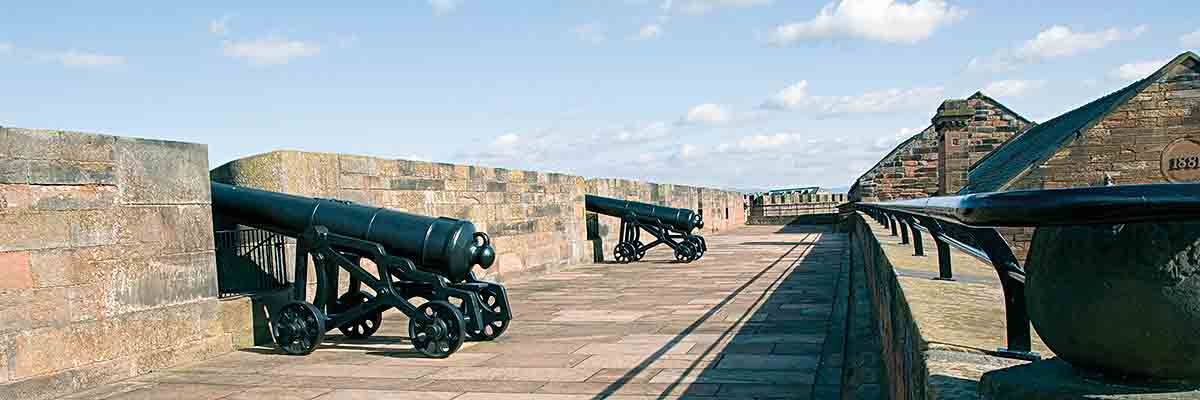Significance of Carlisle Castle
Since the 12th century Carlisle Castle has been in almost continuous military use, which makes it unusual among medieval castles. With such a long history, change and adaptation have been an important part of the castle’s story, with each significant structure built or modified in response to specific events or military requirements. As a border stronghold, the castle has also often played a key role in national events.

Border Stronghold
For over 500 years from 1092, Carlisle was the main point of defence on England’s north-west border. The city and castle were frequently involved in the politics and warfare of the two kingdoms, and Carlisle has been besieged ten times – more than any other place in the British Isles. At least five of these sieges were major and sustained military engagements.
The castle was an important regional basis for the English Crown in the Middle Ages, with particularly notable visits by Henry II (1186), John (1201) and Edward I (1307). In the 15th and early 16th centuries it was the seat of the Lord Warden of the Marches, and also served as a state prison for many important prisoners, notably Mary, Queen of Scots.
Later it housed a barracks and important garrison, as the headquarters until 1962 of the King’s Own Border Regiment.
Curtain Walls
Despite the castle’s turbulent history, its simple 12th-century curtain walls have been its primary defence throughout. No wall towers of the kind seen in so many other English castles of this size and importance were ever added.
Most of Edward I’s castles in north Wales, by contrast, which represent castle design at its most sophisticated in the late 13th century, were never tested by having to withstand a siege.
Outer Gatehouse
The historic interest of the outer gatehouse (De Ireby’s Tower) is enhanced by the fact that detailed building accounts, dating from 1378 to 1382, survive.[1] From these we know that it was designed and built by John Lewyn, one of the great masters of the Perpendicular style.
De Ireby’s Tower is modest in appearance compared to some of Lewyn’s works. His most ambitious works were probably at the northern castles of Raby, Sheriff Hutton and Warkworth, Northumberland (though these works are attributed rather than documented).
16th-Century Defences
The half-moon battery, breastwork and inner ditch, dating from 1542, are the work of a Moravian engineer, Stefan von Haschenperg, and part of a major campaign of defensive works undertaken by Henry VIII to defend England against invasion.
The main threat was from France: although most of Henry’s resources were concentrated on the Channel coast, the French had long regarded Scotland as their key ally against the English, so he had to secure his northern defences too. Von Haschenperg’s work at the castle was the most important upgrading of its defences since the 12th century.
The Keep: English or Scottish?
We do not know exactly when the keep was built, and it has been too much altered to be dated from its architectural details. Henry I ordered Carlisle to be fortified with a ‘castle and towers’ in 1122. He built similar square keeps in several other places, but it is not clear how far work had advanced by the time of his death in 1135.
The Scots occupied Cumberland in that same year, and one English chronicler says that David I of Scotland built the ‘mighty keep’ (‘fortissimam arcem’).[2] David I died there in 1153.[3] Henry II retook Carlisle and Cumberland, and repaired the castle, though the sums of money recorded do not suggest anything on the scale of the keep was built.
So it is possible that the keep was begun between 1122 and 1135 – in the reign of Henry I – but that it was completed, or rebuilt from scratch, by David I during the Scots occupation. If so, it would be the only Anglo-Norman keep built by a Scots king. It is also the only English castle which has been a royal residence for both kings of England and of Scotland.
Footnotes
1. Indenture between the king and John Lewyn, mason: The National Archives E101/483/31, 1378; R Gilyard-Beer, ‘De Ireby’s Tower in Carlisle Castle’, in Ancient Monuments and their Interpretation: Essays Presented to AJ Taylor, ed M Apted, R Gilyard-Beer and AD Saunders (Chichester, 1977), 191–210; MR McCarthy, HRT Summerson and RG Annis, Carlisle Castle: A Survey and Documentary History, English Heritage Archaeological Report 18 (London, 1990), 31–50.
2. RA Brown, HM Colvin and AJ Taylor, The History of the King’s Works, vol 2: The Middle Ages (London, 1963), 595.
3. Ibid, 595–6.
